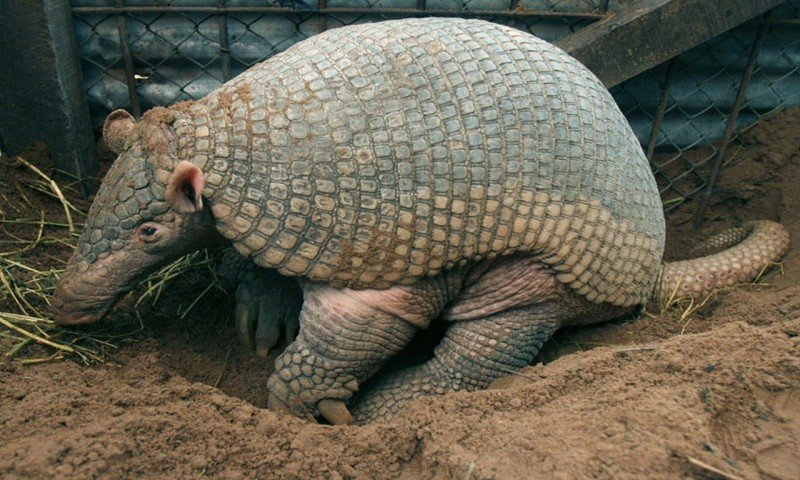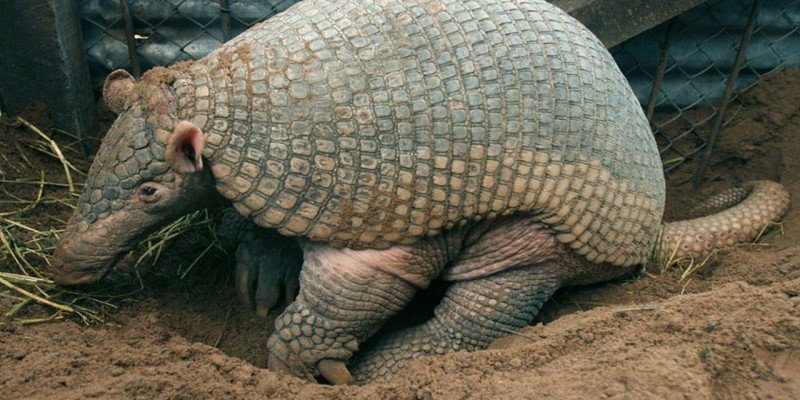
The Giant Armadillo is one of nature’s most fascinating creatures. Imagine a small tank with a tough exterior, squatting quietly in the Amazon rainforest—this is essentially what a giant armadillo looks like. These unique animals boast a hard shell made of bone and keratin, just like armor, allowing them to roam the forests and savannas of South America while providing extensive protection from predators.
Often overshadowed by their smaller relatives, the Giant Armadillo is the largest of all armadillo species. Weighing in at about 100 pounds, they certainly make a statement. But there’s so much more to these playful creatures than just their size. From their quirky habits to their crucial role in the ecosystem, the Giant Armadillo is a wonder we should appreciate.
Physical Characteristics
The Giant Armadillo is a sight to behold. It can grow up to 5 feet in length, including its tail! Its most notable feature is its bony shell, which is covered with overlapping plates of keratin. This shell isn’t just for show; it serves a practical purpose. When threatened, the armadillo can curl into a ball, using its armor to shield its head and vulnerable parts. This defensive posture is not just a quirky trick—it’s a crucial survival tactic.
In addition to their impressive size and armor, Giant Armadillos are also equipped with strong claws that can reach up to 4 inches long. These claws are perfect for digging—their primary method for foraging. Whether it’s hunting for ants, termites, or other insects to munch on, their claws make them efficient diggers, similar to a construction worker using a shovel.
As for their color, Giant Armadillos typically have a brownish or grayish hue that helps them blend into their surroundings. This camouflage is a crucial part of their survival strategy, allowing them to hide from predators such as jaguars and pumas.
Habitat and Distribution
Giant Armadillos primarily inhabit the dense rainforests of South America, specifically countries like Brazil, Paraguay, and Argentina. These areas provide the rich soil and abundant termites that the armadillos thrive on. However, they are not confined solely to rainforests; they can also be found in other habitats, such as savannas and scrublands, where food sources are plentiful.
You might be wondering how they adapt to such diverse environments. Well, Giant Armadillos are incredibly adaptable and can make themselves at home in various habitats, as long as there is enough food. They usually prefer areas with loose soil that makes digging easier, giving them quite an edge when searching for their favorite snacks.
In recent years, though, habitat loss due to deforestation and agricultural expansion has put pressure on their populations. Giant Armadillos are now classified as vulnerable by the IUCN, highlighting the importance of conservation efforts to protect their natural habitats and ensure their survival.
Diet and Feeding Habits
The diet of a Giant Armadillo is primarily composed of insects, particularly ants and termites. With their strong claws and keen sense of smell, they can detect a meal buried deep within the ground. It’s like having a built-in radar system that leads them to dinner! They often dig down several feet to find their tasty morsels, spending hours searching for food.
Interestingly, they have a rather unusual feeding method. Unlike some animals that chew their food, Giant Armadillos swallow their prey whole. This might sound odd, but it makes sense for their diet of soft-bodied insects. It’s similar to how you might quickly gulp down a smoothie—you get the nutrients without any of the chewing effort!
Giant Armadillos are nocturnal feeders, which means they are most active at night. During this time, they roam their territories, foraging for food while avoiding the heat of the day. This behavior not only helps them find food efficiently but also reduces the risk of encountering predators.
Behavior and Social Structure
Despite their size, Giant Armadillos are generally solitary animals. They prefer to roam and forage alone rather than in groups. This isn’t to say they don’t have social interactions; they do! They communicate with one another through vocalizations and scent marking. It’s a bit like leaving a friendly note for a neighbor; they ensure others know they’ve been in the area.
They have a fascinating way of marking their territory—using urine and feces to leave their scent. This behavior helps them avoid unnecessary confrontations with others, allowing them to live peacefully in their habitat. When it’s time to mate, however, they come together for a brief period before returning to their solitary lives.
Giant Armadillos are also known for their playful nature. Young armadillos, in particular, enjoy playing and wrestling with each other, which helps them develop essential skills for survival. Just like human kids playing tag, these activities prepare them for the challenges they’ll face in the wild.
Reproduction and Lifespan
The reproductive habits of the Giant Armadillo are as intriguing as the creature itself. These animals typically mate during the rainy season, which provides ample food for the mother during pregnancy. After a gestation period of about 2-5 months, a mother will usually give birth to one or two offspring, known as pups. It’s an adorable sight to see these tiny creatures, often about the size of a kitten, start to explore their world.
Mother Giant Armadillos are very caring and protective of their young. They often stay with their pups for several months before the little ones venture out on their own. This nurturing phase is crucial, as it allows the pups to learn vital survival skills from their mother, ensuring a greater chance of survival when they reach independence.
As for their lifespan, Giant Armadillos can live up to 15 years in the wild, although they often face threats from predators and habitat loss. In captivity, they can live even longer, benefiting from regular food and protection from dangers they would encounter in the wild. This extended lifespan offers a unique opportunity to study their behavior and biology more closely.
Conservation Status
The Giant Armadillo’s conservation status is a pressing issue. Classified as vulnerable by the International Union for Conservation of Nature (IUCN), their populations are declining due to habitat loss and hunting. As agriculture and urban expansion continue to encroach on their habitats, these remarkable creatures are finding it increasingly difficult to survive.
Efforts are being made to protect the Giant Armadillo and its habitat. Conservation programs focus on preserving the forests they inhabit while raising awareness about their ecological importance. These programs aim to engage local communities in protecting this unique species, showing them that preserving wildlife can also benefit their livelihoods.
Despite these efforts, challenges remain. It’s crucial that we continue to educate ourselves and others about the importance of conservation. By understanding and appreciating the role of the Giant Armadillo in maintaining a healthy ecosystem, we can help ensure these fascinating creatures continue to thrive for generations to come.
| Fact | Details |
| Size | Can grow up to 5 feet long, including the tail. |
| Weight | Can weigh between 50 to 100 pounds. |
| Diet | Primary diet consists of ants and termites. |
| Lifespan | Can live up to 15 years in the wild. |
| Habitat | Primarily found in rainforests, savannas, and scrublands of South America. |
| Reproduction | Mating occurs during the rainy season with a gestation period of 2-5 months. |
FAQ
What do Giant Armadillos look like?
Giant Armadillos are quite distinctive, with a hard, bony shell covered in overlapping plates. They can grow quite large, reaching lengths of up to 5 feet, and their body generally has a brownish or grayish hue. Their long claws help them dig for food, and they have a flexible, elongated snout perfect for sniffing out insects.
Are Giant Armadillos dangerous?
No, Giant Armadillos are not dangerous to humans. They are shy creatures that prefer to avoid confrontation. When threatened, they tend to curl into a ball as a defense mechanism, using their tough armor to protect themselves rather than attacking. They are more likely to run away than engage with potential threats.
How fast can a Giant Armadillo run?
Giant Armadillos aren’t known for their speed; they are generally slow-moving animals. When they do need to flee from danger, they can run at speeds of about 10 miles per hour, which is surprisingly quick for their size. However, they tend to rely more on their armor and digging skills to evade predators rather than running.
Do Giant Armadillos dig their own burrows?
Yes, Giant Armadillos dig their own burrows. These burrows serve as shelters during the day, providing a safe haven from predators and the heat. Additionally, their impressive digging skills allow them to find insects that make up their primary diet. After they dig, they may stay in these burrows for several hours or even overnight.
What is the role of Giant Armadillos in the ecosystem?
Giant Armadillos play a vital role in their ecosystem by helping to control insect populations. As they dig and forage for ants and termites, they aerate the soil, which can benefit plant life. Their burrowing behavior also creates homes for other small animals, making them an essential part of the ecological community.
How do Giant Armadillos communicate?
Giant Armadillos communicate primarily through vocalizations and scent marking. They use sounds like grunts and snorts to express themselves, especially during mating season or when threatened. Additionally, they leave scent markings to indicate territory, similar to how other animals like dogs and cats communicate with each other.
Are Giant Armadillos nocturnal?
Yes, Giant Armadillos are nocturnal animals, meaning they are most active at night. This behavior helps them avoid the heat of the day and increases their chances of finding food. Being nocturnal also reduces encounters with daytime predators, allowing them to go about their foraging activities more safely.
How many babies do Giant Armadillos have?
Giant Armadillos typically give birth to one or two pups at a time. These pups are born very small and vulnerable but grow quickly as they learn from their mother. The mother cares for them diligently, teaching them vital survival skills as they mature.
Are Giant Armadillos endangered?
Giant Armadillos are classified as vulnerable due to habitat loss from deforestation and hunting. Their numbers are declining, making conservation efforts essential for their survival. Protecting their habitats and raising awareness about their ecological importance are crucial steps in ensuring they don’t become endangered.
Can Giant Armadillos swim?
Yes, Giant Armadillos are surprisingly good swimmers despite their heavy build. They can paddle through water when necessary, which can help them escape from predators or cross rivers while foraging for food. Their natural instinct to swim aids their adaptability in various habitats.
How do Giant Armadillos find food?
Their keen sense of smell is crucial when finding food. Giant Armadillos can detect the scent of ants and termites buried beneath the ground. With their strong claws, they dig deep to uncover their prey, making them excellent foragers in their natural habitat. This skill set allows them to thrive in environments where food sources can be buried and hidden.

